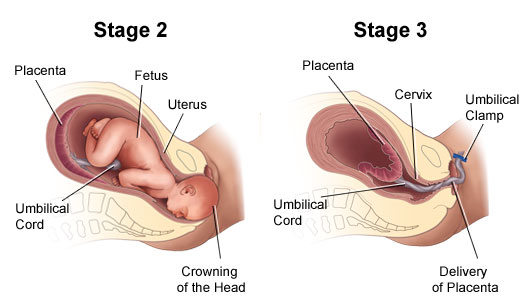Delivering a baby is a tough going and involves a lot of hard work. Hence its designation, labour. “The wonderful result the mother has at the end of it is worth all those pains,” says Oscar Wilde. Let us have some insight into the whole process of childbirth.
Stages of labour
Arbitrarily the whole process of labour has been divided into three stages:
Stage 1: The earliest sign of labour is the occurrence of regular contractions of the womb. When these contractions become stronger, a woman feels these as labour pains. The neck of the womb, known as cervix, tends to dilate and the plug of mucus which had closed its mouth comes off, letting some bloodstained discharge called show, leak out. This occurs during the relaxation period of the womb. During each contraction, which becomes more vigorous and more frequent with the passage of time, the muscles of the womb push the baby’s head against the cervix, thus helping contractions to stretch the cervix. Eventually, the mouth of the cervix is fully dilated.
Thus the interval between the onset of labour pains and the full dilatation of cervix (indicated by appearance of show) constitutes the first stage of labour. Its duration varies from 12 to 24 hours in primigravida and 4 to 12 hours in a multigravida.
A word about recognition of labour pains – do not confuse these with ordinary cramps. Labour pains, unlike cramps, come at regular intervals. To start with the pains come every 20 minutes. Later, the interval may be as small as three to five minutes.
Secondly, the pain starts in the back but then travels round to the front of the tummy. Since the first stage lasts for a long time, there is usually little difficulty in transferring the woman to the hospital.

Stage 2: Once the cervix is fully dilated, the bag of water that surrounds the baby splits. There is thus a leakage of the fluid. At this point labour pain becomes very strong and the mother feels a pressing need to push the baby out. She should cooperate with the attending doctor, midwife and other staff by bearing down (tightening the abdominal muscles) during contractions. In between the pains she must relax.
Eventually, the baby’s head reaches the vulva – the edge of the mother’s body. With the last push the limbs and trunk also come out. As the body escapes, lots of blood-stained fluid (liquir amnii) also gushes out.
The second stage of labour, thus, begins with the complete dilatation of the cervix and ends with the birth of the baby. In a multigravida it is a matter of some minutes, usually 15 minutes. The primigravida, on the other hand, may take an hour or two.
As soon as the baby is born, the umbilical cord is clamped and cut.
Stage 3: After the birth of the baby, the mother relaxes as the doctor is busy in clamping and cutting the cord, the placenta, the so-called afterbirth, from its attachment to the womb. It takes about 10 minutes to do so.
As soon as there are signs indicating separation of the placenta (like lengthening of the cord, further leakage of blood, womb becoming smaller, harder and more globular in shape and mobile from side to side), the woman expels it out by a voluntary effort. If the mother fails to cooperate after all that hard labour and exhaustion, pressing the woman’s abdomen in a definite manner would push it out.
The third stage, therefore, lasts between the birth of the baby and the expulsion of the placenta. It is painless and usually takes about 15 to 20 minutes and seldom more than half an hour. Once labour is over, the mother may have a rigor, a physiological chill, which should be ignored.
At times, delivery of placenta is delayed. In order to overcome this problem, doctors often allow the baby to suckle her breast. This practice releases certain hormones that contract the womb, thereby speeding up expulsion of placenta. In addition, this reduces the blood loss following expulsion of placenta.
About the baby just born, we will talk at length in the next section.
All about conduct of labour Since labour concerns the pregnant woman primarily, she should have some idea how it is going to be conducted. Needless to say at the very outset that the process is completed more or less by nature. The role of the doctor and the midwife is described as “minimal interference”. That cannot be said about the mother-to-be. Her contribution and role is very active indeed.




